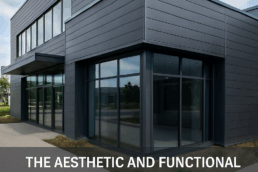Roof flashing is an essential component in roofing systems. They are made to protect your home from leaks and water damage. Flashing acts as a barrier to redirect water away from critical areas on the roof so that moisture does not penetrate the roofing materials and cause damage to the underlying structure.
Without proper flashing, water can easily seep into joints, seams, and other vulnerable areas. Over time, this may lead to mold growth, wood rot, and structural damage. This blog explores the different types of roof flashing, their specific applications, and the benefits they provide in creating stronger, leak-free roofs. Understanding these types can help homeowners and builders make informed decisions to guarantee long-lasting roof protection.
Roof Flashing Types
1. Step Flashing
Application: Used Where the Roof Meets a Wall
Step flashing is a critical type of flashing used where the roof intersects a vertical wall. Each piece of step flashing is bent at a 90-degree angle to fit between the roof and the wall. These pieces are installed in a “stepped” pattern, with each piece overlapping the one below it. This method ensures that water is effectively directed away from the wall-roof junction.
The installation of step flashing requires precision and attention to detail. The process begins with cleaning and inspecting the area where the flashing will be installed for a smooth surface. The first piece of step flashing is placed at the base of the wall and roof junction, secured with roofing nails or screws, and overlapped slightly by the roofing material. Each subsequent piece is placed above the previous one, overlapping both the shingle and the preceding piece of flashing. This creates a cascading effect that channels water away from the roof and wall.
Benefits: Provides a Watertight Seal, Preventing Leaks
The primary benefit of step flashing is its ability to provide a reliable, watertight seal. By overlapping each piece, step flashing makes sure that water cannot infiltrate the roof-wall intersection. This overlapping technique also accommodates the natural movement of the building materials due to thermal expansion and contraction. This maintains the integrity of the seal over time. Step flashing is essential for preventing leaks in areas prone to water accumulation for the longevity and durability of the roof structure.
2. Drip Edge Flashing
Application: Installed Along the Roof Edges
Drip edge flashing is installed along the edges of the roof, particularly at the eaves and rakes. This type of flashing is designed to protect the edges of the roof decking and direct water away from the fascia and into the gutters. It typically consists of a metal strip that extends slightly beyond the roof edge.
Drip edge flashing is strategically installed along the roof’s perimeter, covering the areas most vulnerable to water damage. At the eaves, drip edge flashing ensures that water runs off the roof and directly into the gutters. This prevents it from seeping underneath the shingles and causing damage to the roof deck and fascia. Along the sloped edges of the roof, drip edge flashing provides additional protection by guiding water away from the roof structure.
The installation of drip edge flashing involves placing the metal strips along the edges of the roof before the underlayment and shingles are installed. The flashing is nailed into place, with the outer edge extending beyond the roofline to create an overhang. This overhang is essential for directing water away from the roof and preventing it from pooling at the edges.
Benefits: Prevents Water from Seeping Under the Roofing Material
Drip edge flashing is vital for preventing water from seeping under the roofing material and causing damage to the roof decking and fascia. By extending beyond the edge of the roof, drip edge flashing ensures that water is directed into the gutters, away from the roof structure.
This prevents water from pooling at the edges, which can lead to rot, mold, and structural damage. Additionally, drip edge flashing provides a finished look to the roof edges which improves the overall aesthetic appeal of the roofline.
3. Valley Flashing
Application: Placed in Roof Valleys
Valley flashing is a critical component used in roof valleys, where two roof planes meet to form a V shape. These areas are particularly vulnerable to water accumulation because they channel a significant amount of water runoff. Properly installed valley flashing plays a crucial role in directing water away from the roof valley. When properly installed, it prevents water accumulation, leaks, and potential damage to the roof structure.
Valley flashing is installed along the valleys of a roof, which are the internal angles formed by the intersection of two sloping roof planes. These valleys naturally collect water as it flows down the roof. This makes them one of the most susceptible areas for leaks if not properly protected. Valley flashing is typically made from durable materials such as galvanized steel, aluminum, or copper to withstand heavy water flow and harsh weather conditions.
Benefits: Directs Water Away from the Roof Valley, Preventing Water Accumulation
The main benefit of valley flashing is its ability to direct water away from the roof valley to prevent water accumulation and potential leaks. Proper installation of valley flashing ensures that water flows smoothly down the valley and off the roof, reducing the risk of water infiltration and damage.
Valley flashing is designed to enhance water flow in roof valleys so that water is efficiently channeled off the roof. By directing water away from the valleys, valley flashing prevents water from pooling and seeping into the roofing materials. If not kept in check, this can lead to leaks and structural damage.
4. Chimney Flashing
Application: Installed Around Chimneys
Chimney flashing is an essential component in roofing systems meant to seal the joint between the chimney and the roof. It prevents water from entering the chimney structure and causing damage. Properly installed chimney flashing creates a durable, watertight barrier that protects both the roof and the chimney from leaks. Leaks can lead to structural damage, mold growth, and other serious issues.
Chimney flashing is specifically designed to fit around the base of chimneys, sealing the junction where the chimney meets the roof. This area is particularly prone to leaks because of the different materials and angles involved, which can create gaps where water can infiltrate. Chimney flashing typically consists of several components, including step flashing, counter flashing, and base flashing. These all work together to form a watertight seal.
Benefits: Prevents Water from Entering the Chimney Structure
Chimney flashing provides a watertight seal at the junction of the chimney and roof. This seal is essential for preventing water from seeping into the chimney structure, which can cause extensive damage to both the chimney and the roof. By effectively channeling water away from this vulnerable area, chimney flashing helps to maintain the integrity of the roofing system.
Chimney flashing is typically made from durable materials such as galvanized steel, aluminum, or copper. These materials are chosen for their resistance to corrosion and weathering. The usage of these materials is so that the flashing can withstand the elements and provide long-lasting protection. The durability of chimney flashing materials is vital to make sure that the flashing remains effective over time, even in harsh weather conditions.
5. Vent Pipe Flashing
Application: Used Around Vent Pipes
Vent pipe flashing is designed to create a watertight seal around vent pipes, which protrude from the roof to vent gasses from the plumbing system. This type of flashing is typically made from a flexible material, such as rubber or metal that can form a tight seal around the pipe.
Benefits: Ensures a Watertight Seal Around the Vent Pipe
The primary benefit of vent pipe flashing is its ability to ensure a watertight seal around the vent pipe and prevent leaks and water damage. Proper installation of vent pipe flashing is critical to prevent water from seeping into the roof around the pipe. By maintaining a secure seal, vent pipe flashing helps to protect the roof and the underlying structure from water infiltration. This can prolong the life of the roof and prevent costly repairs.
Understanding the different types of roof flashing and their applications is critical for creating stronger, leak-free roofs. Each type of flashing serves a specific purpose and offers different benefits, from directing water away from vulnerable areas to providing watertight seals around roof penetrations. Proper installation and selection of the right flashing type are essential for long-lasting roof protection.
Roof flashing is a vital part of your roofing system that helps to prevent leaks, water damage, and costly repairs. Whether you are dealing with roof-to-wall joints, roof edges, valleys, chimneys, or vent pipes, using the appropriate type of flashing can make a significant difference in the durability and performance of your roof.
At C&J Metal Products, we specialize in providing high-quality custom metal fabrication services. Our expert team is dedicated to delivering exceptional craftsmanship and ensuring your roof remains strong and leak-free. Contact us today to learn more about our services and how we can help protect your roof with our bespoke metal fabrication solutions.



